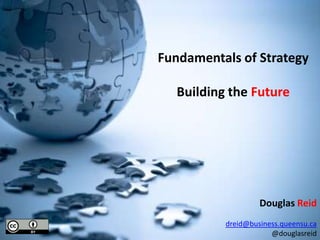
Fcmb march 2011 day 3 revised
- 1. Fundamentals of Strategy Building the Future Douglas Reid dreid@business.queensu.ca @douglasreid
- 2. Recap Estimating the future Break Stress testing assumptions Making choices under uncertainty Lunch Your advice to Executive Mgmt. Conclusion What to read
- 3. Repetition Repetition Repetition Repetition Repetition Repetition Repetition Repetition Repetition Repetition Repetition Repetition Repetition Repetition Repetition Repetition Repetition
- 4. Customer willingness to pay Strategy Cost of delivering what the customer buys
- 5. Implementation happen primarily by changing the allocation of resources consistent with objectives
- 6. Money Brands, equipment, IP, licenses, machinery, information, etc. Any non-human asset of an organization that a manager can deploy
- 8. Time Duration, sequence and project choices to which you apply the money and people that you have
- 9. Misalignment
- 11. Leadership
- 12. To become a more effective leader, I will… Do more of… ___________________ ___________________ ___________________ ___________________ ___________________ Do less of… ___________________ ___________________ ___________________ ___________________ ___________________ Start doing… ___________________ ___________________ ___________________ ___________________ ___________________ Stop doing… ___________________ ___________________ ___________________ ___________________ ___________________
- 13. Customer willingness to pay Strategy Cost of delivering what the customer buys
- 14. Is your strategy “good enough” for the future?
- 15. Why this matters No clear future Range of futures Discrete possible futures Predictable Source: Courtney, Kirkland and Viguerie, 1997
- 19. Social trends / changes
- 22. More or less globalizationBefore After
- 24. Overall threat assessment: 6 1 2 4 5 3 No clear future Range of futures Discrete possible futures 1 2 3 4 5 Overall opportunity assessment: 6 Predictable
- 25. What if…?
- 26. What assumptions have you made?
- 27. Now what?
- 28. Postures Shape the future Adapt to the future Reserve the right to play ____________________ Tactics Scenario planning Option-based decisions “Plan B” Measurement
- 29. Customer willingness to pay Strategy Cost of delivering what the customer buys
- 30. Priorities for our bank Advice to FCMB executive management
- 31. To achieve excellence as a bank, we recommend that FCMB must… Do more of… 1. ___________________ _____________________ 2. ___________________ _____________________ 3. ___________________ _____________________ Do less of… 1. ___________________ _____________________ 2. ___________________ _____________________ 3. ___________________ _____________________ Start doing… 1. ___________________ _____________________ 2. ___________________ _____________________ 3. ___________________ _____________________ Stop doing… 1. ___________________ _____________________ 2. ___________________ _____________________ 3. ___________________ _____________________
- 32. Let’s sum up…
- 33. You always have choices about building your future
- 34. The most important choice is to begin.
- 35. For your staff, only you can create conditions where their desire for excellence can flourish.
- 36. Structural and cultural elements… that enables an organization to: detect discontinuous change early, interpret the consequences, and formulate effective responses. Rene Rohrbeck, 2010
- 37. 1. Operational Decision Making 2. Coaching and Developing Others 3. Empowerment/Delegation 4. Establishing Strategic Direction 5. Influence 6. Financial Acumen 7. Driving Execution 8. Customer Focus
- 38. Customer willingness to pay Strategy Cost of delivering what the customer buys
- 39. What kind of future awaits? No clear future Range of futures Discrete possible futures Predictable Source: Courtney, Kirkland and Viguerie, 1997
- 41. Be clear about your values What will you NOT tolerate?
- 42. Choose action
- 43. Seekand embrace responsibility
- 45. Develop others
- 46. To become a more effective leader, I will… Do more of… ___________________ ___________________ ___________________ ___________________ ___________________ Do less of… ___________________ ___________________ ___________________ ___________________ ___________________ Start doing… ___________________ ___________________ ___________________ ___________________ ___________________ Stop doing… ___________________ ___________________ ___________________ ___________________ ___________________
- 47. What to read Managing, Mintzberg, 2009 Execute, Bossidy and Charan, 2002 What Management Is, Magretta, 2002 The Human Equation, Pfeffer, 1998
- 48. Next step: operational excellence
- 49. Thank you!
Notas do Editor
- Importance to learning and mastery cannot be underestimatedBuild (black text) by me in differerent ways – but not good enough for learning by busy peopleBuild (multi-coloured text) – repetition through practice
- At a macro level….
- Q – what other important topic did we discuss yesterday (day 2) that this picture should remind you of?(BUILD) *** Misalignment- Importance of repetition again to learning
- How do you know?What means do you use to find out?
- BUILD slide -
- Shape the future – establish how industry operates – set technical standards; innovate in products; affect regulation. (willingness to be wrong)Adapt to the future – win by being most agile, fast, flexible – means innovating and experimenting constantly (how failure is treated)Reserve the right to play – invest in small possible futures, not enough to make a significant commitment, but enough to have a toehold if the situation changes (partnerships, vs. acquisitions)
- Rohrbeck, Rene (2010) Corporate Foresight: Towards a Maturity Model for the Future Orientation of a Firm, Springer Series: Contributions to Management Science, Heidelberg and New York,
- Best leader – what did he/she do?
- WHY?
